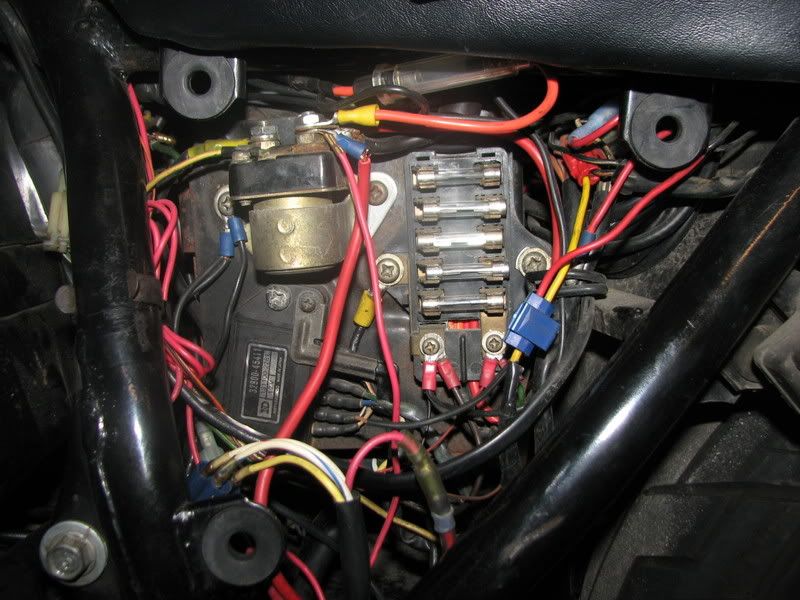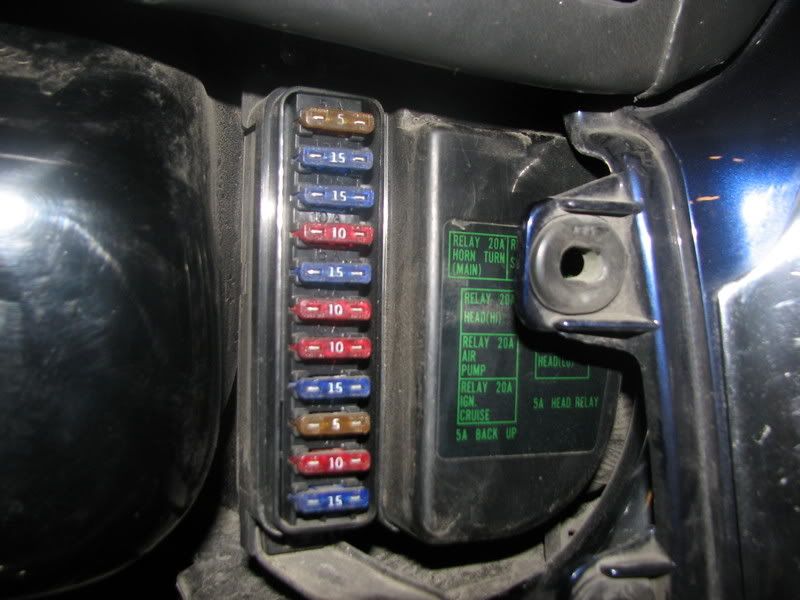If someone could post a picture of their electrical panel (82 - 83 G/GL) I would really appreciate it. I need to see which wires go to battery, solenoid, etc. The ones without the handy dandy color coded jacks lol.
Announcement
Collapse
No announcement yet.
Need a pic of your electrical panel :)
Collapse
X
-
 mortation
mortation
Need a pic of your electrical panel :)
I am a jack a$$ and didnt take a picture of where all those darn wires go. My new battery box should be here in a day or two and I will need to reassemble my electrical panel :P
If someone could post a picture of their electrical panel (82 - 83 G/GL) I would really appreciate it. I need to see which wires go to battery, solenoid, etc. The ones without the handy dandy color coded jacks lol.Tags: None
-
 mortation
mortation -
 catbed
catbed -
Boy, I could really mess you up with a couple of pictures. :shock:
The panel on my wife's '82 850L has had a couple things added to it, but I can still guide you through what goes where. To really mess you up, I could toss a couple pictures of my Wing in there. The stock fuse/relay panel is impressive enough (first glance at the manual shows 13 fuses and 8 relays, and that's not all of them), but then I could show you the accessory panel that I added on the other side of the bike. 8-[
.sigpic
mine: 2000 Honda GoldWing GL1500SE and 1980 GS850G'K' "Junior"
hers: 1982 GS850GL - "Angel" and 1969 Suzuki T250 Scrambler
#1 son: 1986 Yamaha Venture Royale 1300 and 1982 GS650GL "Rat Bagger"
#2 son: 1980 GS1000G
Family Portrait
Siblings and Spouses
Mom's first ride
Want a copy of my valve adjust spreadsheet for your 2-valve per cylinder engine? Send me an e-mail request (not a PM)
(Click on my username in the upper-left corner for e-mail info.)
Comment
-
 mortation
mortation
lol, I am trying to avoid getting messed upOriginally posted by Steve View PostBoy, I could really mess you up with a couple of pictures. :shock:
The panel on my wife's '82 850L has had a couple things added to it, but I can still guide you through what goes where. To really mess you up, I could toss a couple pictures of my Wing in there. The stock fuse/relay panel is impressive enough (first glance at the manual shows 13 fuses and 8 relays, and that's not all of them), but then I could show you the accessory panel that I added on the other side of the bike. 8-[
.
Really everything is pretty easy thanks to connectors and colored wires. My issue is with connecting the battery and solenoid I guess as those were the things with just wires bolted on.
Comment
-
OK, the battery is easy. It goes into its little slot with the vent tube (unless you have a sealed battery) toward the front of the bike, and the positive terminal toward the rear. The solenoid bolts on to the left side of the battery box.
Here is a picture of my wife's cluttered electrical panel. I did not realize how much I really need to clean up the mess here until I took the picture.

Also, as threatened, I tried to get a picture of the stock panel on my Wing, but you have to loosen the left saddlebag mount to get to the relay box, so I just removed the fuse box cover.

Here is a picture of the accessory panel I made for my bike.
The big black strap going up the middle holds the battery into place. The black box with the white panel in the upper left is a relay box for isolating the trailer from the bike wiring. It has four relays that assure full voltage to the trailer lights.
There are two more relays below that box. The left relay connects power to the trailer to charge the small battery in the trailer that runs the dome light when the lid is up. The right relay is for future accessory lighting.
Below those two relays is a common grounding point. All the accessories I have added get grounded here, which is then connected to the battery with a single wire.
The fuse panel on the right has individual connections for front- and rear-seat heated clothing (also used for battery tender input), trailer lights, air horns, front accessories (GPS, satellite radio, etc.), and a spare for future projects. Below that is a self-resetting circuit breaker that powers the fuse panel and can also be used for a take-off point for anything requiring constant power.
The stock main fuse for the bike is under the black cover on the far right. It uses two 55-watt fusible links in parallel, to be sure it can handle the 90-amp alternator that has been installed.
 sigpic
sigpic
mine: 2000 Honda GoldWing GL1500SE and 1980 GS850G'K' "Junior"
hers: 1982 GS850GL - "Angel" and 1969 Suzuki T250 Scrambler
#1 son: 1986 Yamaha Venture Royale 1300 and 1982 GS650GL "Rat Bagger"
#2 son: 1980 GS1000G
Family Portrait
Siblings and Spouses
Mom's first ride
Want a copy of my valve adjust spreadsheet for your 2-valve per cylinder engine? Send me an e-mail request (not a PM)
(Click on my username in the upper-left corner for e-mail info.)
Comment
-
 mortation
mortation
Thanks steve but thats not the same electrical panel I have. My fuse box doesnt have anything screwed into the bottom of it, and I have the square fuses. I guess its probably pretty similar.
Basically I was wondering.
Black wire goes from engine to - battery terminal. + battery terminal goes to which place on the solenoid? And what is the other post on the solenoid go to?
Comment
-
I guess the square fuses were one of the upgrades for '83?
There should be a heavy wire (usually black, but the electricity doesn't care) from the negative terminal on the battery to the engine and/or chassis. The positive terminal of the battery will connect to one of the large terminals on the starter solenoid. Electrically it does not matter which one, so just choose the one that makes sense when routing the wire. Usually, the right terminal goes to the battery. The other large terminal on the solenoid goes to the starter motor. The smaller wire on the solenoid will come from the starter button. There might also be a ground wire connected to the body of the solenoid.
There should also be a wire that feeds the main fuse of the fuse box. Some people route this to the battery, I prefer to route it to the stater solenoid. to minimize connections at the battery. Yeah, you don't have to change the battery very often, but since some people remove the battery (or at least the wires) to charge it, it still gets wires taken off of it more often than the solenoid.
.sigpic
mine: 2000 Honda GoldWing GL1500SE and 1980 GS850G'K' "Junior"
hers: 1982 GS850GL - "Angel" and 1969 Suzuki T250 Scrambler
#1 son: 1986 Yamaha Venture Royale 1300 and 1982 GS650GL "Rat Bagger"
#2 son: 1980 GS1000G
Family Portrait
Siblings and Spouses
Mom's first ride
Want a copy of my valve adjust spreadsheet for your 2-valve per cylinder engine? Send me an e-mail request (not a PM)
(Click on my username in the upper-left corner for e-mail info.)
Comment
-
 mortation
mortation
Thanks! So two wires from the battery, one to the solenoid and one to the fuse box? Any idea where on the fuse box?Originally posted by Steve View PostI guess the square fuses were one of the upgrades for '83?
There should be a heavy wire (usually black, but the electricity doesn't care) from the negative terminal on the battery to the engine and/or chassis. The positive terminal of the battery will connect to one of the large terminals on the starter solenoid. Electrically it does not matter which one, so just choose the one that makes sense when routing the wire. Usually, the right terminal goes to the battery. The other large terminal on the solenoid goes to the starter motor. The smaller wire on the solenoid will come from the starter button. There might also be a ground wire connected to the body of the solenoid.
There should also be a wire that feeds the main fuse of the fuse box. Some people route this to the battery, I prefer to route it to the stater solenoid. to minimize connections at the battery. Yeah, you don't have to change the battery very often, but since some people remove the battery (or at least the wires) to charge it, it still gets wires taken off of it more often than the solenoid.
.
Comment
-
 catbed
catbed -
That would depend on whether they changed the fuse box other than handling the square fuses.Originally posted by mortation View PostThanks! So two wires from the battery, one to the solenoid and one to the fuse box? Any idea where on the fuse box?
In the three bikes I have available ('81 850, '82 650L, '82 850L), the top fuse handles the head and tail lights. The second fuse handles all the signals, that includes turn signals, brakes and horn. The third fuse is for the ignitor and the coils. The fourth fuse is the main fuse, the fifth one is for the accessory terminals at the end of the fuse panel. Your wire to the battery would connect to one side of the fourth fuse and also to the fifth fuse. The other side of the fourth fuse will lead to the ignition switch, and will meet the output of the r/r along the way.
Hope this helps.
.sigpic
mine: 2000 Honda GoldWing GL1500SE and 1980 GS850G'K' "Junior"
hers: 1982 GS850GL - "Angel" and 1969 Suzuki T250 Scrambler
#1 son: 1986 Yamaha Venture Royale 1300 and 1982 GS650GL "Rat Bagger"
#2 son: 1980 GS1000G
Family Portrait
Siblings and Spouses
Mom's first ride
Want a copy of my valve adjust spreadsheet for your 2-valve per cylinder engine? Send me an e-mail request (not a PM)
(Click on my username in the upper-left corner for e-mail info.)
Comment
-
 mortation
mortation
Man I hope I did this right. I found two little circle grounds (Black wire, white stripe from the R/R & fuse box connector) and just ran a line from the engine and bolted them all together.
Comment
.png)


Comment